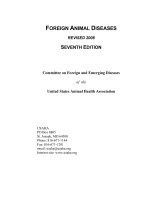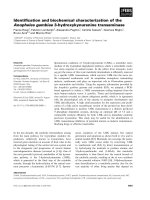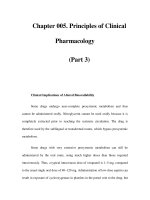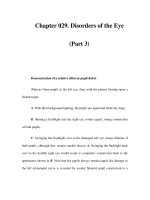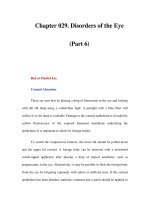Chapter 091. Benign and Malignant Diseases of the Prostate (Part 3) docx
Bạn đang xem bản rút gọn của tài liệu. Xem và tải ngay bản đầy đủ của tài liệu tại đây (61.8 KB, 5 trang )
Chapter 091. Benign and Malignant
Diseases of the Prostate
(Part 3)
The PSA criteria used to recommend a diagnostic prostate biopsy have
evolved over time. The goal is to increase the sensitivity of the test for younger
men more likely to die of the disease and to reduce the frequency of detecting
cancers of low malignant potential in elderly men more likely to die of other
causes. Age-specific reference ranges reduce the upper limit of normal for younger
men and increase it for older men. Different thresholds alter the sensitivity and
specificity of detection. The threshold for performance of a biopsy was 4.0 ng/mL,
which has been reduced to 2.6 ng/mL for men <60 by many groups based on the
finding that nearly half of the men with PSAs who reached this level increased to
4 within a relatively short (4-year) time frame, and that, once diagnosed, nearly
one-third had spread beyond the confines of the gland. Most PSA is complexed to
α
1
-chymotrypsin (ACT); only a small percentage is "free." To improve diagnostic
accuracy for men with a PSA between 4 and 10, the risk of cancer is under 10% if
the free PSA is >25% but as high as 56% for those with a free PSA <10%. PSA
density measurements were developed to correct for the contribution of BPH to
the total PSA level. PSA density is calculated by dividing the serum PSA by the
prostate weight estimated from transrectal ultrasound (TRUS). Values <0.10
ng/mL per cm
3
are consistent with BPH, while those >0.15 suggest cancer. PSA
velocity is the rate of change in PSA levels over time and is expressed most
commonly as the PSA doubling time. It is particularly useful for men with
seemingly normal values that are rising. For men with a PSA above 4, rates of rise
>0.75 ng/mL per year suggest cancer, while for those with lower PSA levels, rates
above 0.5 ng/mL per year should be used to advise a biopsy. As an example, an
increase from 2.5 to 3.2 in a 1-year period would warrant further testing. Free and
complexed PSA measurements are used when levels are between 4 and 10 ng/mL
to decide whether a biopsy is needed. The level of free PSA is lower in men with
cancer. The ratios of free to total, complexed to total, and free to complexed PSA
have also been used. In one series, specificity improved by 20% by defining
normal ranges as free/total >0.15, complexed/total <0.70, and free/complexed
>0.25.
PSA-based detection strategies have changed the clinical spectrum of the
disease. Now, 95–99% of newly diagnosed cancers are clinically localized, 40%
are not palpable, and of these, 70% are pathologically organ-confined. The
downside of widespread PSA screening is the detection and treatment of cancers
with such a low malignant potential that they would not have shortened survival or
produced symptoms during the patient's lifetime. The side effects of treatment,
including impotence, incontinence, and bowel dysfunction, are unacceptable for
these patients. Formal clinical trials to assess the value of screening on prostate
cancer morbidity and mortality are ongoing. Until the results of these studies are
available, men are advised to make an informed decision about whether to
undergo testing.
A diagnostic algorithm based on the DRE and PSA findings is illustrated in
Fig. 91-2. In general, a biopsy is recommended if the DRE or PSA is abnormal.
Twenty-five percent of men with a PSA >4 ng/mL and an abnormal DRE have
cancer, as do 17% of men with a PSA of 2.5–4.0 ng/mL and normal DRE.
Figure 91-2
Algorithm for diagnostic evaluation of men based on digi
tal rectal
examination and prostate-specific antigen levels.
Prostate Biopsy
A diagnosis of cancer is established by a TRUS-guided needle biopsy.
Direct visualization by ultrasound or MRI assures that all areas of the gland are
sampled. A minimum of six separate cores, three from the right and three from the
left, is advised, as is a separate biopsy of the transition zone if clinically indicated.
More commonly, 12–14 cores are advised to increase the diagnostic yield. Patients
with prostatitis should have a course of antibiotics before biopsy. Men with an
abnormal PSA and negative biopsy are advised to undergo a repeat biopsy.
Each core of the biopsy is examined for the presence of cancer, and the
amount of cancer is quantified based on the length of the tumor within the core
and the percentage of the core involved.


